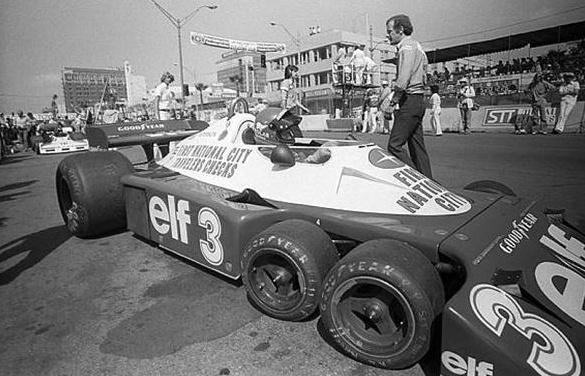September 25, 2008

Okay, yes, it looks a little weird to our eyes, but there was a good concept behind it. Since the biggest cause of drag on a F1 car is the tires, and by the rules you can't cover the tires with bodywork, just make the front tires smaller! Brilliant!
Of course, by reducing the size of the steering tires, you lose grip. No problem, just add another set! Add a well-faired nose, and you've almost managed to cover the tires completely and still stay within the rules. Now THAT'S how F1 is supposed to work. Brake cooling was a constant problem however, and the front tires constantly distorted at high speed (being smaller than the rears, they rotated faster. Stresses easily dealt with by the larger tires became much more pronounced in the 10" fronts). The car also had unique steering properties... so much so that while Patrick Depailler was able to figure it out, his teammate Jody Scheckter was never comfortable behind the wheel.
In 1976, the P34 actually finished 1-2 at the Swedish Grand Prix, took 2nd at the Japanese Grand Prix in a huge rainstorm, and had some other podiums as well. While it competed in 1977, shortly thereafter the rules were changed to define a F1 car as having four wheels, consigning the car to the ash heap of history.
Corgi released a diecast car of the P34, which I was lucky enough to own back when I was a young duckling. Wish I knew what happened to it!
Posted by: Wonderduck at
09:47 AM
| Comments (7)
| Add Comment
Post contains 259 words, total size 2 kb.
Posted by: madmike at September 25, 2008 10:43 AM (mV2q+)
Posted by: David at September 25, 2008 12:59 PM (khRGN)
Posted by: Steven Den Beste at September 25, 2008 05:14 PM (+rSRq)
Steven, it's funny you should say that... the prototype of the P34 actually did have an airscoop, but sometime before the car took the track for the '76 season, it disappeared.
Posted by: Wonderduck at September 25, 2008 07:59 PM (AW3EJ)
After all these years, you just linked to this page again, and I visited it again.
That last picture doesn't show an airscoop. Notice that you can see the engine? What you thought was an airscoop is actually the body folded back to reveal the engine.
Posted by: Steven Den Beste at February 19, 2011 06:47 PM (+rSRq)
Then there was this weird configuration used only at the P34's first race and never seen again. Let's slowly move away and forget we ever saw that... eesh.
Posted by: Wonderduck at February 19, 2011 07:49 PM (W8Men)
I wasn't able to determine what they all were from my photos, but I was able to identify two as the March 76, and Lotus 77. I suspect two others were March bodies in other livery. I'll have to look up what the Shadow team was using, and whether Jagermeister was just a sponsor or what. The McLarens of a little after that era showed what seemed to be the trend, the top of the engine was exposed, but the bodywork was fully enclosed on the sides with the exhaust in ports like we see now.
Posted by: David at February 19, 2011 10:10 PM (xcVNq)
47 queries taking 0.063 seconds, 240 records returned.
Powered by Minx 1.1.6c-pink.









